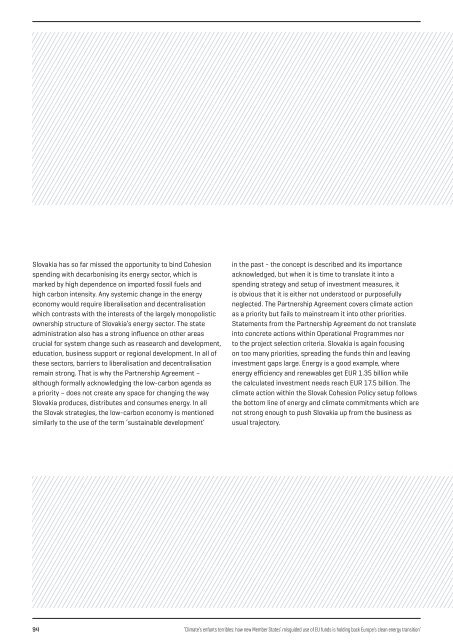ENFANTS TERRIBLES
enfants-terribles
enfants-terribles
You also want an ePaper? Increase the reach of your titles
YUMPU automatically turns print PDFs into web optimized ePapers that Google loves.
Slovakia has so far missed the opportunity to bind Cohesion<br />
spending with decarbonising its energy sector, which is<br />
marked by high dependence on imported fossil fuels and<br />
high carbon intensity. Any systemic change in the energy<br />
economy would require liberalisation and decentralisation<br />
which contrasts with the interests of the largely monopolistic<br />
ownership structure of Slovakia’s energy sector. The state<br />
administration also has a strong influence on other areas<br />
crucial for system change such as reasearch and development,<br />
education, business support or regional development. In all of<br />
these sectors, barriers to liberalisation and decentralisation<br />
remain strong. That is why the Partnership Agreement –<br />
although formally acknowledging the low-carbon agenda as<br />
a priority – does not create any space for changing the way<br />
Slovakia produces, distributes and consumes energy. In all<br />
the Slovak strategies, the low-carbon economy is mentioned<br />
similarly to the use of the term ‘sustainable development’<br />
in the past - the concept is described and its importance<br />
acknowledged, but when it is time to translate it into a<br />
spending strategy and setup of investment measures, it<br />
is obvious that it is either not understood or purposefully<br />
neglected. The Partnership Agreement covers climate action<br />
as a priority but fails to mainstream it into other priorities.<br />
Statements from the Partnership Agreement do not translate<br />
into concrete actions within Operational Programmes nor<br />
to the project selection criteria. Slovakia is again focusing<br />
on too many priorities, spreading the funds thin and leaving<br />
investment gaps large. Energy is a good example, where<br />
energy efficiency and renewables get EUR 1.35 billion while<br />
the calculated investment needs reach EUR 17.5 billion. The<br />
climate action within the Slovak Cohesion Policy setup follows<br />
the bottom line of energy and climate commitments which are<br />
not strong enough to push Slovakia up from the business as<br />
usual trajectory.<br />
94<br />
‘Climate’s enfants terribles: how new Member States’ misguided use of EU funds is holding back Europe’s clean energy transition’


